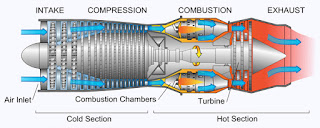JET Engine
Compressor – at the front of the engine are fan blades, some rotating (rotors) and some static (stators), which draw air into the engine. There are many rows of blades and as the air passes by each row it becomes more pressurised and the temperature increases.
Combustion chamber – this pressurised air is then sprayed with fuel (most commonly Jet A or Jet A-1 which are of kerosene type) and then an electric spark ignits the fuel and air mixture in the chamber. This causes the air/fuel mixture to burn, massively increasing pressure and temperature.
Turbines – the hot pressurised gas is drawn out of the engine by a turbine at the rear which takes energy out of the gas and causes a drop in pressure and temperature. As the pressure decreases, the gas flows faster (think about letting go of an inflated balloon). The energy from the gas that drives the turbine at the rear is what powers the rotation of the compressor which draws in air at the front. The high velocity gases being released through the nozzle at the rear is what causes the thrust. To understand this we refer to Newton’s Third Law of Motion: for every action there is an equal and opposite reaction. As the gas rushes out of the back an equal and opposite force is exerted forward. Think about when you push the wall of a swimming pool to glide off in the opposite direction; even though the force of your pushing is directed towards the wall, an equal and opposite reaction force causes you to travel in the opposite direction.
At approximately 400 mph, one pound of thrust equals one horsepower, but at higher speeds this ratio increases and a pound of thrust is greater than one horsepower. At speeds of less than 400 mph, this ratio decreases. This force allows large planes like the 747 to fly at speeds up to 600mph.
There are different types of jet engine too such as the Turboprop. You’ll know if it’s a Turboprop type by the large extruding propellers at the front, which are responsible for the thrust as most of the energy from the gas is transferred to the compressor by the rear turbines, so the exerted gas is not responsible for the thrust.
Turboshaft is the type found in helicopter rotors, power plants and even the M1 tank. The process is similar to the turboprop however,instead of driving propellors, the rotating shaft can power a variety of devices such as pumps, generators, wheels and generally anything that spins. -
Modern large aircrafts use a High-Bypass Turbofan which are similar to the standard turbojet engine except that a large fan at the front draws in more air to the engine. However, not all of the air goes through the compressor and turbines, with most of the air actually bypassing the core and travelling through ducts on the outside of the core (on average 5 times more air is bypassed than actually travelling through the core). These are more efficient especially at subsonic speeds (ie. below the speed of sound, 768 mph) and are also a lot quieter whilst still having the ability to accelerate a vehicle heavier than a locomotive from 0 to 200 mph in less than 60 seconds.
If you want to find out more you can check out these awesome interactive pages from GE or Boeing‘s, ‘Journey through a jet engine’. Both of course, both being world leaders in jet engine production.



Comments